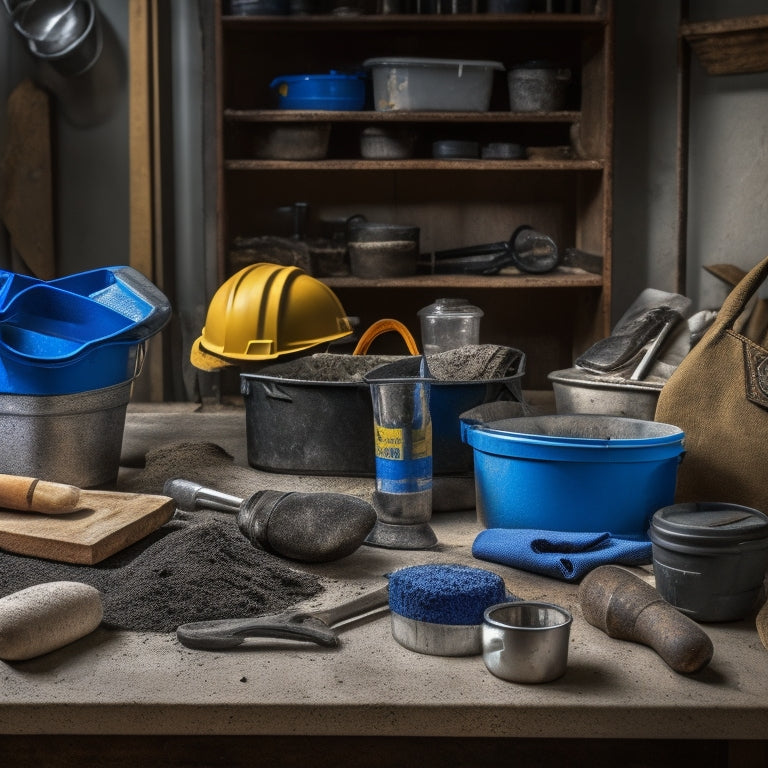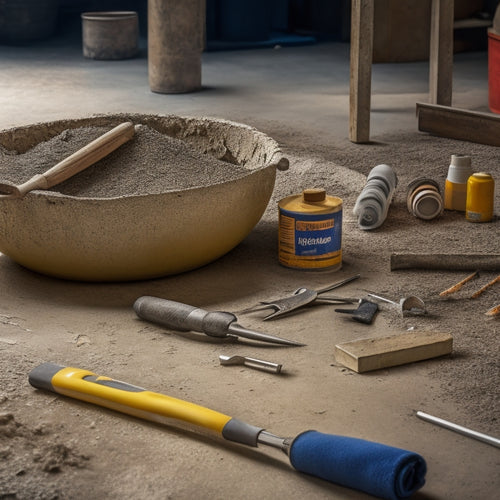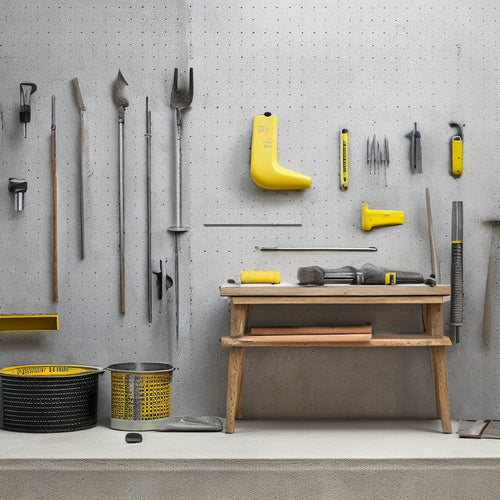
5 Tools Needed for Quick Fix Concrete Mixing
Share
You'll need five essential tools to tackle a quick fix concrete mixing project efficiently. First, you'll require a sturdy mixing bucket that can hold the entire concrete batch. Next, grab a handy trowel and float to smooth and level the concrete. A concrete mixer or drill is necessary for thorough mixing, and don't forget to have measuring and leveling tools on hand to guarantee accurate proportions. Finally, protect yourself with safety goggles and gloves to prevent injuries. With these essential tools, you'll be well-prepared to achieve a professional finish - and understanding the nuances of each tool will make all the difference in your project's success.
Key Takeaways
• A sturdy mixing bucket, either metal or plastic, is essential to hold the entire concrete batch and prevent overfilling accidents.
• A handy trowel is necessary for spreading and smoothing concrete, allowing for precise control and a professional finish.
• A concrete mixer or drill is required for efficient mixing, with adjustable speed settings and a stable power source.
• Accurate measuring tools, such as a digital scale and measuring cups, ensure proper proportions of ingredients for strong and durable concrete.
• Safety goggles and chemical-resistant gloves are crucial for protecting eyes and skin from debris and harsh chemicals during the mixing process.
Essential Mixing Bucket Requirements
When mixing quick fix concrete, you'll need a bucket that meets specific requirements to guarantee a successful and efficient process. The right mixing bucket is vital to achieving a consistent mix and avoiding accidents.
There are two primary mixing bucket types to take into account: metal and plastic. Metal buckets are durable and can withstand heavy use, but they can corrode over time. Plastic buckets are lightweight and resistant to corrosion, but they may not be as durable.
When it comes to mixing bucket sizes, you'll need to choose one that can hold the right amount of concrete for your project. A common size is a 5-gallon bucket, which is suitable for small to medium-sized projects. However, if you're working on a larger project, you may need a 10-gallon or even 20-gallon bucket.
Make sure to select a bucket that's large enough to hold the entire batch of concrete, as overfilling can lead to accidents and messes. Remember, a sturdy and well-sized mixing bucket is essential to ensuring a safe and successful quick fix concrete mixing process.
Handy Trowel and Float Tools
Handy Trowel and Float Tools
You'll need a reliable trowel and float to finish your quick fix concrete project, as these tools help you achieve a smooth, even surface. Mastering trowel techniques and float finishes is essential for a professional-looking result.
Here are some essential tools to take into account:
| Tool | Description | Benefits |
|---|---|---|
| Trowel | Used for spreading and smoothing concrete | Allows for precise control and even distribution |
| Float | Used for finishing and leveling concrete | Creates a smooth, even surface and helps remove air pockets |
| Edger | Used for creating clean edges and joints | Helps prevent cracks and guarantees a clean finish |
| Tamping Tool | Used for compacting and leveling concrete | Assures a solid, even base for your project |
When using these tools, remember to always wear protective gear, including gloves, safety glasses, and a dust mask. This will help prevent injuries and guarantee a safe working environment. By mastering the use of these tools and techniques, you'll be able to achieve a high-quality finish for your quick fix concrete project.
Concrete Mixer and Drill Needs
With your finishing tools in hand, you'll need a reliable concrete mixer and drill to get the job done efficiently and effectively. A concrete mixer is essential for mixing and blending concrete ingredients, while a drill is necessary for mixing and applying the concrete.
When selecting a concrete mixer, consider the following key factors:
-
Mixer capacity: Choose a mixer that can handle the volume of concrete you need to mix. A larger mixer capacity will save you time and effort.
-
Drill speed: Opt for a drill with adjustable speed settings to guarantee the right speed for your concrete mixing needs.
-
Power source: Decide between electric, gasoline, or manual-powered mixers and drills, depending on your specific requirements and preferences.
Remember to always follow safety guidelines when operating power tools, and make certain you have a stable and level work surface to prevent accidents.
Measuring and Leveling Tools
You'll need accurate measuring and leveling tools to guarantee your concrete mix is properly proportioned and your finished project is perfectly aligned. Measuring accuracy is vital to confirm the right amount of cement, sand, and water are combined. A digital scale or measuring cups will help you achieve precise measurements. Don't skip this step, as incorrect proportions can lead to a weak or brittle concrete.
For leveling, you'll need a spirit level and a straightedge. These tools will help you achieve a perfectly level surface, which is essential for a professional-looking finish. Use the spirit level to check the surface for any deviations from the horizontal or vertical plane. Then, use the straightedge to guide your trowel and confirm an even application of the concrete.
Safety Goggles and Gloves Essentials
Before starting to mix concrete, put on safety goggles and gloves to protect yourself from flying particles and harsh chemicals. You don't want to risk getting concrete in your eyes or skin, as it can cause serious irritation and even long-term damage.
When it comes to selecting protective gear, here are some essentials to take into account:
-
Impact-resistant goggles: These provide excellent eye protection from flying debris and chemicals.
-
Chemical-resistant gloves: These prevent harsh chemicals from penetrating the skin, keeping your hands safe and healthy.
-
Durable, grip-enhancing palms: These guarantee you maintain a secure grip on your tools, even in wet or slippery conditions.
Frequently Asked Questions
Can I Mix Concrete in a Metal Bucket?
You're wondering if you can mix concrete in a metal bucket. The answer is yes, but be cautious. Metal buckets can react with the alkalinity in concrete, affecting its strength.
Opt for a bucket made from non-reactive materials like plastic or fiberglass instead. When mixing, use proper techniques to avoid splashing and guarantee even distribution.
Always prioritize safety by wearing protective gear, including gloves and goggles, to prevent skin and eye irritation.
How Do I Prevent Concrete From Sticking to Tools?
To prevent concrete from sticking to your tools, you'll want to prioritize concrete release and tool maintenance.
Before mixing, lightly spray your tools with a release agent or cooking spray. This will guarantee easy cleanup and prevent concrete from bonding.
After use, wash your tools with soap and water, and dry them thoroughly to prevent rust.
Regularly lubricating your tools will also help prevent concrete from sticking.
Can I Use a Cordless Drill for Mixing Concrete?
Can you use a cordless drill for mixing concrete? Yes, but it's essential to choose the right drill specifications for the task.
Look for a drill with high torque and a slow speed setting to effectively mix the concrete.
Additionally, employ proper mixing techniques, such as starting at the edges and working your way inwards, to avoid creating air pockets.
What Is the Ideal Temperature for Mixing Concrete?
When mixing concrete, you're probably wondering what the ideal temperature is.
The best mixing conditions occur between 50°F and 70°F (10°C and 21°C).
If it's too cold, the concrete sets slowly, and if it's too hot, it sets too quickly.
Be aware of the concrete temperature effects, as they can impact the final product's strength and durability.
Make certain to mix in a temperature-controlled environment to secure a strong and safe concrete structure.
Can I Mix Concrete in Small Batches?
You're wondering if you can mix concrete in small batches? Absolutely!
Mixing small batches offers several advantages, including better quality control, reduced waste, and easier handling.
To get it right, focus on perfecting your mixing techniques, like thoroughly combining ingredients and avoiding overmixing.
With small batches, you can guarantee a consistent mix and avoid safety risks associated with large quantities.
Conclusion
You've got the basics covered, now it's time to get mixing.
With your trusty bucket, trowel, and float by your side, you're ready to tackle any concrete job.
Add a reliable mixer and drill to the mix, and you'll be pouring like a pro.
Don't forget to measure and level with precision, and always prioritize safety with goggles and gloves.
With these five essential tools, you'll be fixing concrete in no time, and your DIY skills will be solid as rock.
Related Posts
-

Top Tools for Repairing Cracked Concrete Surfaces
When tackling a cracked concrete surface repair, you'll need the right tools to guarantee a durable fix. Start with e...
-

10 Must-Have Tools for Concrete Repair Organization
You'll need a solid organization system to keep your concrete repair tools and materials within easy reach, protected...
-

Top Tools for Mixing Concrete at Home
When mixing concrete at home, you'll need a range of tools to guarantee a successful operation. Start with essential ...


